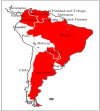Is Stevia rebaudiana Bertoni a Non Cariogenic Sweetener? A Review
- PMID: 26712732
- PMCID: PMC6274104
- DOI: 10.3390/molecules21010038
Is Stevia rebaudiana Bertoni a Non Cariogenic Sweetener? A Review
Abstract
Stevia rebaudiana Bertoni is a small perennial shrub of the Asteraceae (Compositae) family that is native to South America, particularly Brazil and Paraguay, where it is known as "stevia" or "honey leaf" for its powerful sweetness. Several studies have suggested that in addition to their sweetness, steviosides and their related compounds, including rebaudioside A and isosteviol, may offer additional therapeutic benefits. These benefits include anti-hyperglycaemic, anti-hypertensive, anti-inflammatory, anti-tumor, anti-diarrheal, diuretic, and immunomodulatory actions. Additionally, critical analysis of the literature supports the anti-bacterial role of steviosides on oral bacteria flora. The aim of this review is to show the emerging results regarding the anti-cariogenic properties of S. rebaudiana Bertoni. Data shown in the present paper provide evidence that stevioside extracts from S. rebaudiana are not cariogenic. Future research should be focused on in vivo studies to evaluate the effects on dental caries of regular consumption of S. rebaudiana extract-based products.
Keywords: Stevia rebaudiana Bertoni; dental caries; sweetener.
Conflict of interest statement
The authors declare no conflict of interest.
Figures
Similar articles
-
Stevia rebaudiana Bertoni bioactive effects: From in vivo to clinical trials towards future therapeutic approaches.Phytother Res. 2019 Nov;33(11):2904-2917. doi: 10.1002/ptr.6478. Epub 2019 Aug 18. Phytother Res. 2019. PMID: 31423662 Review.
-
The Natural Sweetener Stevia: An Updated Review on its Phytochemistry, Health Benefits, and Anti-diabetic Study.Curr Diabetes Rev. 2024;20(2):e010523216398. doi: 10.2174/1573399819666230501210803. Curr Diabetes Rev. 2024. PMID: 37138480 Review.
-
Stevia as a Natural Sweetener: A Review.Cardiovasc Hematol Agents Med Chem. 2020;18(2):94-103. doi: 10.2174/1871525718666200207105436. Cardiovasc Hematol Agents Med Chem. 2020. PMID: 32031079 Review.
-
Study of Stevia rebaudiana Bertoni antioxidant activities and cellular properties.Int J Food Sci Nutr. 2015;66(5):553-8. doi: 10.3109/09637486.2015.1038223. Epub 2015 May 26. Int J Food Sci Nutr. 2015. PMID: 26008718
-
Antimicrobial potential of extracts from Stevia rebaudiana leaves against bacteria of importance in dental caries.Acta Odontol Latinoam. 2012;25(2):171-5. Acta Odontol Latinoam. 2012. PMID: 23230637
Cited by
-
Effects of Sweeteners on the Gut Microbiota: A Review of Experimental Studies and Clinical Trials.Adv Nutr. 2019 Jan 1;10(suppl_1):S31-S48. doi: 10.1093/advances/nmy037. Adv Nutr. 2019. PMID: 30721958 Free PMC article.
-
Synergistic inhibitory activity of Glycyrrhizae Radix and Rubi Fructus extracts on biofilm formation of Streptococcus mutans.BMC Complement Med Ther. 2023 Jan 28;23(1):22. doi: 10.1186/s12906-023-03861-9. BMC Complement Med Ther. 2023. PMID: 36709283 Free PMC article.
-
Awareness and Knowledge about Sugar Substitutes among Population in Riyadh Region.J Pharm Bioallied Sci. 2021 Jun;13(Suppl 1):S263-S267. doi: 10.4103/jpbs.JPBS_725_20. Epub 2021 Jun 5. J Pharm Bioallied Sci. 2021. PMID: 34447089 Free PMC article.
-
Mitochondriotropic and Cardioprotective Effects of Triphenylphosphonium-Conjugated Derivatives of the Diterpenoid Isosteviol.Int J Mol Sci. 2017 Sep 26;18(10):2060. doi: 10.3390/ijms18102060. Int J Mol Sci. 2017. PMID: 28954424 Free PMC article.
-
Food sweeteners: Angels or clowns for human health?Curr Res Food Sci. 2025 Mar 12;10:101032. doi: 10.1016/j.crfs.2025.101032. eCollection 2025. Curr Res Food Sci. 2025. PMID: 40190385 Free PMC article. Review.
References
-
- Dye B.A., Tan S., Smith V., Lewis B.G., Barker L.K., Thornton-Evans G., Eke P.I., Beltrán-Aguilar E.D., Horowitz A.M., Li C.H. Trends in oral health status: United States, 1988–1994 and 1999–2004. Vital Health Stat. 2007;248:1–92. - PubMed
-
- Ferro R., Besostri A., Meneghetti B., Olivieri A., Benacchio L., Tabaccanti S., Mazzoleni S., Favero G., Stellini E. Oral health inequalities in preschool children in North-Eastern Italy as reflected by caries prevalence. Eur. J. Paediatr. Dent. 2007;8:13–18. - PubMed
-
- Ferrazzano G.F., Scaravilli M.S., Ingenito A. Dental and periodontal health status in Campanian children and relation between caries experience and socio-economic behavioural factors. Eur. J. Paediatr. Dent. 2006;7:174–178. - PubMed
Publication types
MeSH terms
Substances
LinkOut - more resources
Full Text Sources
Other Literature Sources
Medical




